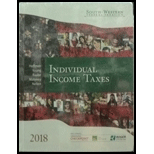
South-western Federal Taxation 2018: Individual Income Taxes
41st Edition
ISBN: 9781337385886
Author: William H. Hoffman, James C. Young, William A. Raabe, David M. Maloney, Annette Nellen
Publisher: Cengage Learning
expand_more
expand_more
format_list_bulleted
Concept explainers
Question
Chapter 18, Problem 39P
a.
To determine
Determine the tax year that Joint venture must adopt for the given circumstances.
b.
To determine
Determine the tax year that Joint venture must adopt for the given circumstances.
Expert Solution & Answer
Want to see the full answer?
Check out a sample textbook solution
Students have asked these similar questions
Suppose Chrysler Motors has 720 million shares outstanding with a share price of $68.25, and $30 billion in debt. If in three years, Chrysler has 750 million shares outstanding trading for $76 per share, how much debt will Chrysler have if it maintains a constant debt-equity ratio? Want a solution
MCQ
I Want Answer
Chapter 18 Solutions
South-western Federal Taxation 2018: Individual Income Taxes
Ch. 18 - Prob. 1DQCh. 18 - Prob. 2DQCh. 18 - Prob. 3DQCh. 18 - Prob. 4DQCh. 18 - Prob. 5DQCh. 18 - Prob. 7DQCh. 18 - Prob. 8DQCh. 18 - Prob. 9DQCh. 18 - Prob. 10DQCh. 18 - Prob. 12DQ
Ch. 18 - LO.2 Emerald Motors is an automobile dealer. The...Ch. 18 - Prob. 14DQCh. 18 - Prob. 15DQCh. 18 - Prob. 16DQCh. 18 - Prob. 17DQCh. 18 - Prob. 18DQCh. 18 - LO.2, 5 What are the similarities between the crop...Ch. 18 - Prob. 20DQCh. 18 - Prob. 21DQCh. 18 - Prob. 22DQCh. 18 - LO.6 Largo Company is an engineering consulting...Ch. 18 - Prob. 24DQCh. 18 - Prob. 25DQCh. 18 - Prob. 26DQCh. 18 - Prob. 27CECh. 18 - Prob. 28CECh. 18 - Prob. 29CECh. 18 - Prob. 30CECh. 18 - Prob. 31CECh. 18 - Prob. 32CECh. 18 - Prob. 33CECh. 18 - Prob. 34CECh. 18 - Prob. 37CECh. 18 - Prob. 39PCh. 18 - Prob. 40PCh. 18 - Prob. 41PCh. 18 - Prob. 42PCh. 18 - Prob. 43PCh. 18 - Prob. 44PCh. 18 - Prob. 45PCh. 18 - Prob. 46PCh. 18 - Prob. 47PCh. 18 - Prob. 48PCh. 18 - Prob. 49PCh. 18 - Jeffrey Boyd, the president of Eagle Furniture...Ch. 18 - Floyd, a cash basis taxpayer, has received an...Ch. 18 - Prob. 52PCh. 18 - Prob. 53PCh. 18 - Prob. 54PCh. 18 - Prob. 55PCh. 18 - Prob. 56PCh. 18 - Prob. 57PCh. 18 - Prob. 58PCh. 18 - Ostrich Company makes gasoline storage tanks....Ch. 18 - Prob. 61PCh. 18 - Grouse Company is a furniture retailer whose...Ch. 18 - Lavender Manufacturing Company began business in...Ch. 18 - Silver Creek Ranch LLC is a small, family-owned...Ch. 18 - Prob. 65PCh. 18 - Prob. 66PCh. 18 - Prob. 67PCh. 18 - Prob. 68PCh. 18 - Ven Company is a retailer. In 2018, its before-tax...Ch. 18 - Prob. 1RPCh. 18 - Prob. 2RPCh. 18 - Prob. 4RPCh. 18 - Paula has sales that qualify to be reported on the...
Knowledge Booster
Learn more about
Need a deep-dive on the concept behind this application? Look no further. Learn more about this topic, accounting and related others by exploring similar questions and additional content below.Similar questions
- Suppose Chrysler Motors has 720 million shares outstanding with a share price of $68.25, and $30 billion in debt. If in three years, Chrysler has 750 million shares outstanding trading for $76 per share, how much debt will Chrysler have if it maintains a constant debt-equity ratio?arrow_forwardCalculate the predetermined overheadarrow_forwardCompute the variable overhead spending variancearrow_forward
- Harrison Home Maintenance bought equipment for $12,600 on January 1, 2020. It has an estimated useful life of six years and zero residual value. Harrison uses the straight-line method to calculate depreciation and records depreciation expense at the end of every month. As of June 30, 2020, the book value of this equipment shown on its balance sheet will be:arrow_forwardNonearrow_forwardcorrect answer is accountingarrow_forward
arrow_back_ios
SEE MORE QUESTIONS
arrow_forward_ios
Recommended textbooks for you





